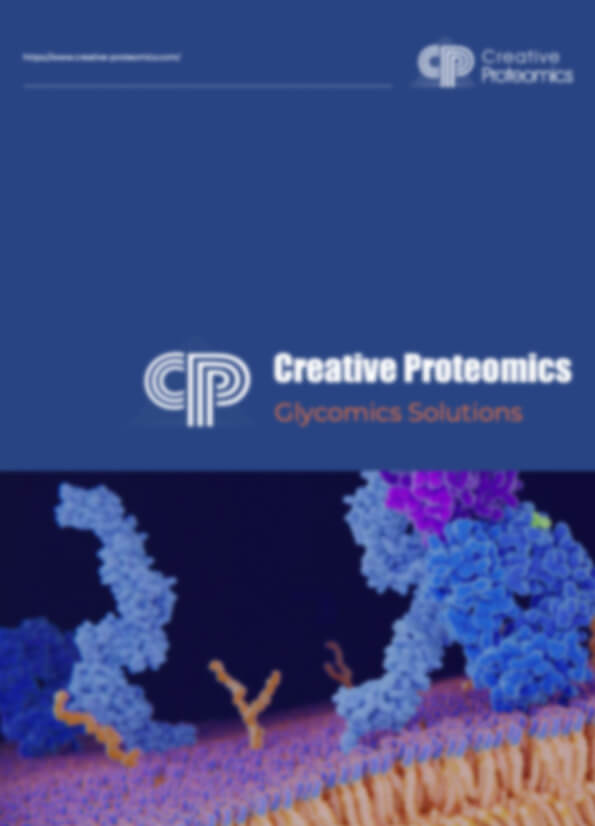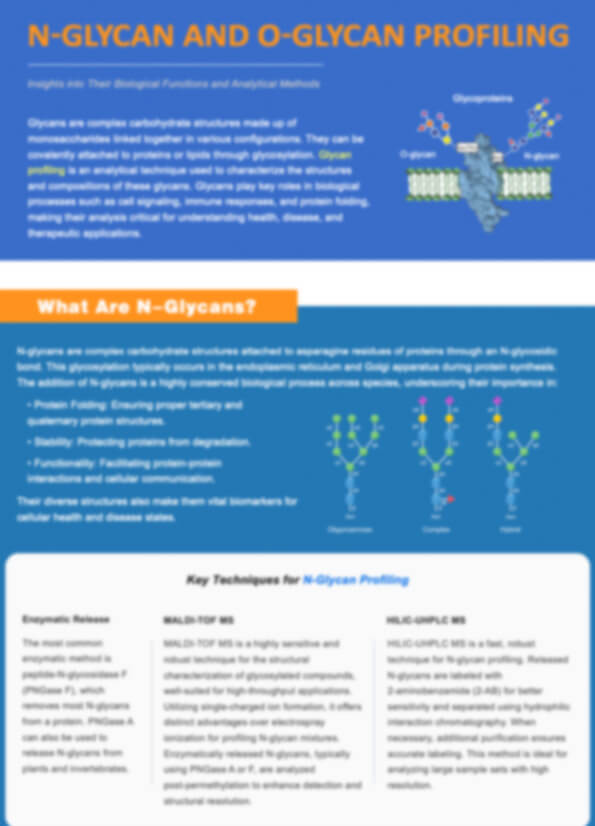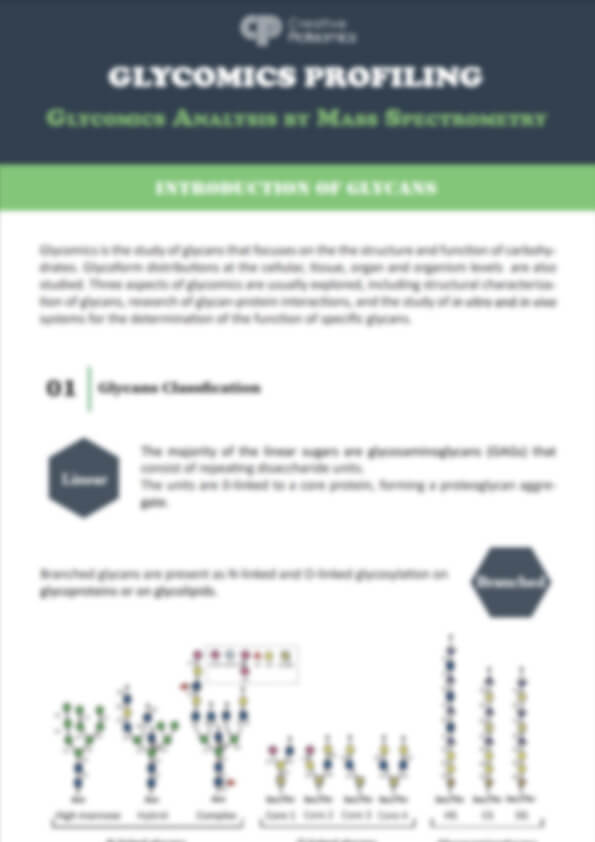Raffinose Analysis Service
Creative Proteomics offers precise raffinose analysis services using advanced technologies like HPLC, HPAE-PAD, and UPLC-MS/MS. We provide accurate quantification, metabolite profiling, and customized solutions to support research in plant physiology, food quality, fermentation, and bioenergy. Our services help optimize crop yields, improve food processing, and enhance functional food development, addressing the growing demand for high-quality, trace-level carbohydrate analysis in various industries.
Submit Your Request Now
×- What We Provide
- Advantages
- Technology Platform
- Sample Requirements
- FAQ
- Publications
What is Raffinose?
Raffinose (C₁₈H₃₂O₁₆) is a trisaccharide composed of galactose, glucose, and fructose, belonging to the raffinose family of oligosaccharides (RFOs). It is naturally abundant in legumes (e.g., beans), cruciferous vegetables (e.g., cabbage, broccoli), and grains. Unlike sucrose, raffinose resists hydrolysis in monogastric organisms (e.g., humans, poultry) due to the absence of α-galactosidase (α-GAL), leading to fermentation by gut microbiota and gas production. Beyond its dietary role, raffinose is critical in cryopreservation for cell desiccation and serves as a precursor for sucralose synthesis.
Raffinose Analysis Service Offered by Creative Proteomics
- Raffinose Quantitative Analysis: Accurate measurement of raffinose levels in food matrices (e.g., processed grains, beverages), plant tissues, and agricultural products.
- Metabolite Profiling: Detection of RFO derivatives, including stachyose (tetrasaccharide) and verbascose (pentasaccharide), to study metabolic pathways.
- Stability Studies: Monitoring raffinose degradation under thermal or enzymatic stress for food processing optimization.
- Customized Solutions: Tailored protocols for niche applications such as functional food development or plant stress response research.
List of Detectable Raffinose-Related Metabolites
| Metabolite | Type | Detection Limit (ppm) |
|---|---|---|
| Raffinose | Trisaccharide | 0.5 |
| Stachyose | Tetrasaccharide | 0.8 |
| Verbascose | Pentasaccharide | 1.2 |
| D-Galactose | Monosaccharide | 0.3 |
| Sucrose | Disaccharide | 0.4 |
Advantages of Raffinose Assay
- Multi-Technology Synergy: Integration of HPLC-RID, HPAE-PAD, and UPLC-MS/MS platforms allows tailored method selection based on sample complexity and research goals.
- Ultra-Low Detection Limits: Achieve quantification thresholds as low as 0.3 ppm for monosaccharides (e.g., D-galactose) and 0.5 ppm for raffinose, enabling trace-level analysis in biological fluids and fermented products.
- Multi-Component Parallel Detection: Simultaneously quantify raffinose, stachyose, verbascose, and their hydrolysis products (e.g., sucrose, D-glucose) in a single run, reducing workflow redundancy.
- High-Throughput Capability: Process up to 200 samples/day using automated Agilent 1260 Infinity II systems, ideal for large-scale agricultural or food quality control studies.
- Matrix Adaptability: Validated protocols for lipid-rich extracts (e.g., seed oils), viscous beverages, and freeze-dried plant tissues, with recovery rates consistently >85% even in challenging matrices.
Technology Platforms for Raffinose Analysis Service
High-Performance Liquid Chromatography with Refractive Index Detection (HPLC-RID)
- Instrument: Agilent 1260 Infinity II HPLC System (G7162A RID)
- Column: Agilent Hi-Plex Ca (7.7 × 300 mm, 8 µm)
- Application: Baseline separation of raffinose isomers (e.g., α/β-anomers) in plant extracts and dairy products
High-Performance Anion-Exchange Chromatography with Pulsed Amperometric Detection (HPAE-PAD)
- Instrument: Dionex ICS-6000 System
- Column: CarboPac PA20 (3 × 150 mm)
- Application: Quantify galactose, glucose, and fructose in hydrolyzed raffinose samples (e.g., enzymatic digestion studies)
Ultra-Performance Liquid Chromatography-Tandem Mass Spectrometry (UPLC-MS/MS)
- Instrument: Waters ACQUITY UPLC I-Class Plus / Xevo TQ-S micro
- Ionization Mode: Electrospray Ionization (ESI) in negative mode
- Application: Structural confirmation of raffinose derivatives (e.g., acetylated raffinose) in synthetic biology samples.

Agilent 1260 Infinity II HPLC (Figure from Agilent)

Waters ACQUITY UPLC I-Class Plus (Figure from Waters)
Sample Requirements for Raffinose Analysis Service
| Sample Type | Minimum Sample Amount | Preferred Container | Storage Conditions | Notes |
|---|---|---|---|---|
| Plant Tissue (Leaves, Seeds, Roots) | 200 mg (Fresh) or 100 mg (Dried) | Sterile centrifuge tube or sealed sample bag | -80°C for long-term storage or on dry ice for shipping | Remove soil and debris, freeze immediately after collection. Avoid repeated freeze-thaw cycles. |
| Food Products (Grains, Legumes, Vegetables) | 1 g (Solid) or 5 mL (Liquid) | Sterile plastic container or vacuum-sealed bag | -20°C for solid samples, 4°C for liquids | Ensure representative sampling and homogenize thoroughly if necessary. |
| Human or Animal Blood | 1 mL | EDTA or heparin-coated tube | 4°C for short-term, -80°C for long-term storage | Centrifuge to separate plasma or serum if needed. Avoid hemolysis. |
| Urine | 5 mL | Sterile collection tube | 4°C for short-term, -80°C for long-term storage | Collect midstream samples and freeze promptly. |
| Feces | 0.5 g | Sterile fecal collection tube | -80°C | Store immediately at -80°C. Avoid contamination during collection. |
Applications of Raffinose Assay Service
Plant Physiology and Stress Response Studies
Analyze raffinose levels to investigate plant responses to environmental stresses such as drought, cold, and salinity.
Crop Improvement and Agricultural Research
Assess raffinose content in crops to enhance seed viability, germination rates, and overall yield.
Food Quality and Processing
Evaluate raffinose concentrations in legumes and grains to optimize food processing and reduce anti-nutritional factors.
Nutritional Composition Analysis
Determine raffinose content in food products for accurate nutritional labeling and dietary formulation.
Fermentation and Bioenergy Research
Study raffinose metabolism in microbial fermentation processes to improve biofuel production and other biotechnological applications.
Functional Food and Prebiotic Development
Investigate the prebiotic effects of raffinose to support the development of functional foods that promote gut health.
Demo
FAQ of Raffinose Analysis Service
How do you ensure accuracy in low-concentration samples?
We employ pre-concentration techniques (e.g., solid-phase extraction) and validate recovery rates (85–110%) for trace-level analyses.
Can you analyze raffinose in fermented products?
Yes. Our protocols include microbial inactivation steps to prevent enzymatic interference during sample preparation.
What is the MOQ for custom method development?
A minimum of 20 samples is required to optimize and validate tailored protocols.
Do you provide stability-indicating assays?
Yes. We design forced degradation studies (heat, pH, oxidation) to identify raffinose breakdown products.
How are data delivered?
Clients receive a comprehensive report with raw chromatograms, calibration curves, and statistical analysis in PDF/Excel formats.
Learn about other Q&A.
Raffinose Analysis Service Case Study
Publications
Here are some of the glycomics-related papers published by our clients:

- Identification of the O-Glycan Epitope Targeted by the Anti-Human Carcinoma Monoclonal Antibody (mAb) NEO-201. 2022. https://doi.org/10.3390/cancers14204999
- Modulation of the Endomembrane System by the Anticancer Natural Product Superstolide/ZJ-101. 2023. https://doi.org/10.3390/ijms24119575
- Conformational differences between functional human immunodeficiency virus envelope glycoprotein trimers and stabilized soluble trimers. 2019. https://doi.org/10.1128/jvi.01709-18
- Alternative glycosylation controls endoplasmic reticulum dynamics and tubular extension in mammalian cells. 2021. https://doi.org/10.1126/sciadv.abe8349
References
- Yang, Hongmei, et al. "Identification of reducing and nonreducing neutral carbohydrates by laser‐enhanced in‐source decay (LEISD) MALDI MS." Journal of Mass Spectrometry 48.5 (2013): 539-543. https://doi.org/10.1002/jms.3202
- Jorge, Tiago F., et al. "Quantification and structural characterization of raffinose family oligosaccharides in Casuarina glauca plant tissues by porous graphitic carbon electrospray quadrupole ion trap mass spectrometry." International Journal of Mass Spectrometry 413 (2017): 127-134. https://doi.org/10.1016/j.ijms.2016.05.004












